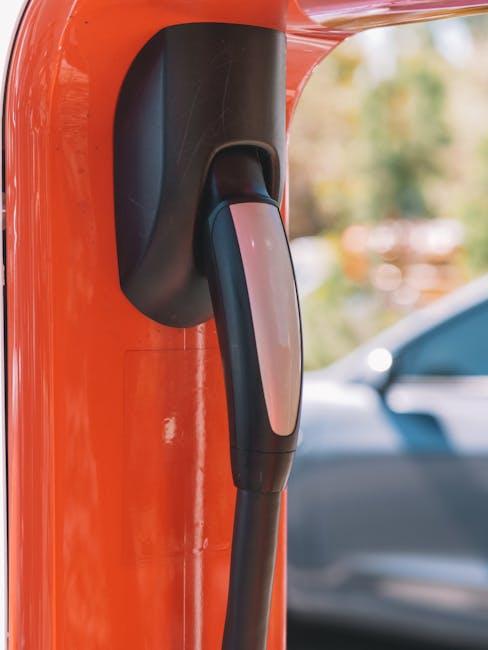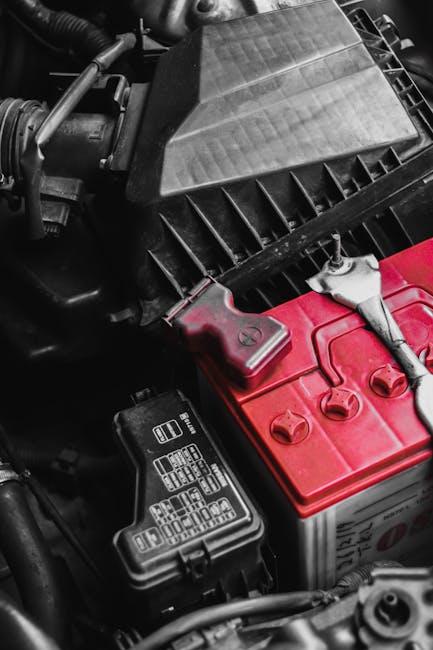As winter’s chill sets in and the days grow shorter, your car battery faces a seasonal challenge unlike any other. The cold weather can sap its strength, leaving you stranded just when you need your vehicle the most. Understanding how to maintain your car battery during these frosty months isn’t just about convenience—it’s about ensuring reliability and peace of mind on every journey. In this article, we’ll explore practical tips and essential maintenance strategies to help your car battery weather the winter with resilience, keeping you on the road no matter how low the temperature drops.
Table of Contents
- Choosing the Right Battery for Cold Weather Performance
- Signs Your Car Battery Needs Attention Before Winter
- Effective Cleaning Techniques to Prevent Corrosion
- Smart Charging Practices to Extend Battery Life
- Tips for Insulating Your Battery Against Freezing Temperatures
- Routine Checks and Maintenance to Avoid Winter Breakdowns
- Q&A
- Future Outlook

Choosing the Right Battery for Cold Weather Performance
When selecting a battery that thrives in winter conditions, it’s essential to prioritize models designed to deliver dependable power despite freezing temperatures. Look for batteries with high cold cranking amps (CCA), as they indicate the battery’s ability to start your engine quickly in cold weather. Additionally, opting for batteries with enhanced reserve capacity ensures your vehicle can handle short bursts of energy without strain, even when temperatures drop drastically.
Consider these key factors when evaluating cold weather battery options:
- Cold Cranking Amps (CCA): A higher CCA rating provides stronger starting power in cold climates.
- Reserve Capacity (RC): Ensures sustained power output when electrical demand spikes.
- Battery Type: AGM (Absorbent Glass Mat) batteries are often more resilient to cold and vibration than traditional flooded batteries.
- Warranty & Brand Reputation: Trustworthy brands typically offer warranties that reflect confidence in cold weather performance.
| Battery Type | Typical CCA Range | Best For |
|---|---|---|
| Flooded Lead-Acid | 400-600 | General Use, Mild Winters |
| AGM | 600-800+ | Extreme Cold, High Performance |
| Gel | 450-700 | Vibration Resistance, Cold Climates |

Signs Your Car Battery Needs Attention Before Winter
Before the bitter chill sets in, your car battery may start whispering subtle warnings that it’s time for some extra care. Watch for signs like slow engine cranking, which might leave you stranded on a frosty morning, and dim headlights that fail to pierce through early winter dusk. Another telltale indicator is an illuminated battery warning light on your dashboard—don’t ignore this glowing hint. Pay attention to corrosion buildup around the battery terminals, as this can obstruct the electrical flow vital for a reliable start.
Some common symptoms to keep an eye on include:
- Difficulty Starting: Engine turns over sluggishly or not at all.
- Electrical Problems: Accessories like the radio or heated seats malfunction.
- Swollen Battery Case: A bulging or deformed exterior is a red flag.
- Old Age: Batteries older than 3-5 years often need replacing.
| Symptom | What It Means |
|---|---|
| Slow Crank | Reduced charge capacity |
| Corrosion | Poor connection & possible charge loss |
| Warning Light | Charging system issue |
| Swollen Case | Internal damage or heat stress |

Effective Cleaning Techniques to Prevent Corrosion
Maintaining a clean battery surface is essential to prolong its life and ensure optimal performance, especially during the harsh winter months. Begin by disconnecting the battery cables with the engine off, then removing any dirt, grease, or corrosion buildup using a soft brush and a solution of baking soda mixed with water. This natural mixture neutralizes acidic deposits, preventing further deterioration. After scrubbing, rinse carefully with water and dry thoroughly. Remember, clean terminals promote better electrical conductivity, which means reliable starts even in freezing temperatures.
To keep corrosion at bay throughout the season, follow these practical tips:
- Apply a thin layer of petroleum jelly or battery terminal protector spray to shield exposed metal parts.
- Inspect battery cables regularly for cracks or frays that could expose wiring to moisture.
- Ensure terminals are tightened securely to minimize electrical resistance.
- Consider using a battery insulating blanket to maintain optimal operating temperature.
| Cleaning Agent | Purpose | Key Benefit |
|---|---|---|
| Baking Soda Solution | Neutralizes acid | Removes corrosion safely |
| Petroleum Jelly | Protects terminals | Prevents moisture buildup |
| Terminal Protector Spray | Seals connections | Extends battery life |

Smart Charging Practices to Extend Battery Life
Charging your car battery wisely during the chilly months can make a significant difference in its longevity and performance. Avoid overcharging, which not only wastes energy but can also damage the battery’s internal components. Aim to charge your battery slowly and consistently using a smart charger designed for cold weather. These devices optimize the current flow, ensuring the battery is neither undercharged nor overcharged, preserving its health throughout winter’s demanding conditions.
Incorporate a few simple techniques to enhance charging efficiency and battery care:
- Charge when the battery is cool: Cold batteries charge better and avoid overheating.
- Use a trickle charger: Ideal for maintaining charge without stressing the battery.
- Disconnect unnecessary electronics: Minimizes drain and allows full charging capacity.
| Charging Method | Benefit | Recommended Use |
|---|---|---|
| Smart Charger | Optimizes charging cycles | Best for winter storage |
| Trickle Charger | Maintains steady charge | Long-term parking |
| Rapid Charger | Fast but riskier | Emergency only |

Tips for Insulating Your Battery Against Freezing Temperatures
When temperatures plunge, protecting your battery from the biting cold is crucial to ensure your car starts smoothly every time. Start by placing an insulating battery blanket or wrap specifically designed for automotive use around the battery. These thermal covers act like a cozy jacket, trapping heat and preventing the battery’s chemical processes from slowing down. If a professional wrap isn’t available, a thick towel or foam insulation can serve as a temporary barrier, but make sure it doesn’t obstruct engine parts or ventilation.
Additional practical measures include:
- Parking your vehicle in a garage to shield it from harsh exposure
- Using a battery box or insulated tray to elevate and protect the battery from cold surfaces
- Regularly checking for corrosion and cleaning terminals to ensure efficient current flow
- Charging your battery fully before extreme cold hits to boost its internal resistance
| Insulating Method | Benefits | Considerations |
|---|---|---|
| Battery Blanket | Consistent heat retention | Requires electrical connection |
| Foam Insulation | Non-electrical, easy to install | May compress over time |
| Garage Parking | Protects entire vehicle | Not always accessible |
| Towel Wrap | Quick and inexpensive | Temporary, risk of moisture buildup |

Routine Checks and Maintenance to Avoid Winter Breakdowns
One of the most effective ways to keep your car battery healthy during the chilly months is by performing routine inspections. Start by cleaning the battery terminals to remove corrosion, which can block the electrical connection and reduce efficiency. Use a mixture of baking soda and water with a soft brush for this task. Regularly check the battery’s fluid levels if it’s not a sealed type, and top off with distilled water when necessary. Remember, cold weather thickens motor oil and makes starting the engine harder, so keeping your battery in peak condition helps prevent those frustrating winter morning fails.
Additionally, incorporate these simple yet impactful maintenance steps into your winter routine:
- Test Voltage Regularly: Use a multimeter to ensure the battery voltage stays above 12.4 volts.
- Secure the Battery: A loose battery can vibrate and cause internal damage, especially on icy roads.
- Limit Short Trips: Brief drives limit battery recharge; aim for longer drives to keep the charge topped up.
- Insulate the Battery: Consider a battery blanket to retain heat and improve cold-start reliability.
| Maintenance Action | Purpose | Frequency |
|---|---|---|
| Terminal Cleaning | Prevent corrosion build-up | Monthly |
| Voltage Testing | Monitor battery health | Bi-weekly |
| Fluid Level Check | Maintain electrolyte balance | Every 2 weeks |
| Insulation Application | Protect against cold temps | Once per season |
Q&A
Q: Why is it important to maintain my car battery during winter?
A: Winter’s freezing temperatures can sap your battery’s power and reduce its efficiency. Maintaining your car battery during winter ensures reliable starts, prevents unexpected breakdowns, and extends your battery’s lifespan.
Q: How does cold weather affect my car battery?
A: Cold weather thickens the engine oil and reduces the chemical reactions inside the battery, making it harder for the battery to deliver enough power to start your engine. It can also increase the risk of battery failure due to higher electrical demands like heater and defroster use.
Q: What are the signs my battery needs winter maintenance or replacement?
A: If your battery is over three years old, struggles to start the car on cold mornings, shows corrosion on terminals, or if dashboard warning lights flicker, it’s time to check and possibly service your battery before winter hits hard.
Q: How can I maintain my car battery throughout the winter months?
A: Regularly check and clean battery terminals to prevent corrosion, ensure your battery is fully charged, and keep your car in a garage or sheltered area if possible. Using a battery maintainer or trickle charger can help keep the charge steady during long periods of inactivity.
Q: Can I use any special products to protect my battery from the cold?
A: Yes, battery insulation kits or heated battery blankets are designed to keep your battery warm during extreme cold snaps, helping maintain its efficiency and reliability. Always follow manufacturer instructions when using these products.
Q: Should I perform any tests on my battery before winter begins?
A: Absolutely. A simple battery load test or checking the voltage with a multimeter can give you insight into your battery’s health. Many auto shops offer free winter battery testing as part of routine maintenance.
Q: Is it better to replace an old battery before winter?
A: If your battery is nearing the end of its lifespan or shows signs of weakness, it’s wiser to replace it before winter arrives. Cold weather amplifies battery issues, so proactive replacement can save you from being stranded in freezing conditions.
Q: How often should I start and run my car during winter to keep the battery charged?
A: If you don’t drive daily, start your car and let it run for about 15-20 minutes every few days. This practice helps recharge the battery and keeps the engine components lubricated, reducing wear and tear.
Q: Can poor battery maintenance impact other car systems in winter?
A: Yes, a weak battery can strain the alternator and cause problems with electrical systems like heated seats, defrosters, and lighting. Maintaining your battery helps your entire vehicle run smoothly during harsh winter months.
Q: What is the key takeaway for keeping my car battery healthy in winter?
A: Winter challenges your battery like no other season, but with proper care—regular checks, cleaning, charging, and protective measures—you can ensure your car starts strong every cold morning, keeping you safe and stress-free on winter roads.
Future Outlook
As winter’s chill sets in, your car battery faces its toughest test. By taking a few thoughtful steps—regularly checking connections, keeping it clean, and ensuring it’s fully charged—you can help your battery brave the cold and keep your engine purring smoothly. Remember, a little winter care now can save you from unexpected roadside surprises later. So, bundle up your battery with attention and routine, and let your car greet the frosty mornings with confidence and ease.


2 Comments
ichdqj
ichdqj